PaulCowan/iStock/GettyImages
For a cook with a sense of humor, the opportunity of offering guests a "knuckle sandwich" can be too good to pass up. The so-called knuckle roast, or peeled knuckle, is a name sometimes given to sirloin tip roasts. It's a group of three relatively small muscles, cut from the portion of the beef round next to the sirloin. Together they form a single roast that's suitable either for oven-roasting or braising as pot roast.
Oven-Roasted Knuckle
Pick any scraps of surface fat from the roast, and pat it dry with clean paper towels. There should be no visible rind of fat or connective tissue on a peeled knuckle -- that's why it's called "peeled" -- but there are often small pieces left behind.
Heat a heavy skillet over medium-high heat. Pour in 1/2 tablespoon of oil, then brown the knuckle on all sides until it's well-seared. Season the roast with salt and pepper or other flavorings as desired, then transfer it to the rack of your roasting pan.
Roast the browned knuckle at 300 to 325 degrees Fahrenheit for approximately 30 minutes per pound. Knuckle roasts are typically 3 1/2 to 4 pounds, so your cooking time will be around 1 1/2 to 2 hours.
Test the roast with an instant-read thermometer. Knuckle isn't an especially tender roast to begin with, so it is tenderest if cooked only to medium-rare or 145 F. You'll need to remove it from the oven when it's 130 F to 135 F, because its temperature continues to rise as it sits.
Rest the beef for at least 10 to 15 minutes before carving it to serve hot. For sandwiches, allow it to cool for up to 2 hours and then wrap and refrigerate it for later use. It is tenderest when sliced thinly.
Pot Roast
Dry the surface of the roast and remove any residual fat or connective tissue. Brown it thoroughly in a hot skillet, then transfer the roast to a Dutch oven, deep casserole dish or slow cooker.
Season the roast liberally with salt and pepper, or any other combination of spices and herbs to taste. Add onions, garlic and other aromatic ingredients, then pour in enough water, broth or other liquids to immerse the bottom one-third to one-half of the beef.
Simmer the roast in your oven at 300 to 325 F, or in your slow cooker on its "High" setting, for 3 to 4 hours or until it's very tender. You should be able to stick a fork into the roast and easily twist off a morsel of beef. For the tenderest texture, comparable to pulled pork, it should reach an internal temperature of 195 F to 205 F.
Remove the pot roast from its cooking juices using a slotted spoon or tongs. It might break or fall apart, so have a plate or platter in your other hand to set the roast on as soon as you lift it clear of the liquid. Cover the beef loosely with foil, and set it aside to rest.
Strain the cooking juices and thicken them, to make a sauce or gravy. Serve it with the beef and your choice of side dishes.
Related Articles
How to Cook a Seven Bone Pot Roast in ...
How to Cook a Lamb Square Cut Shoulder
How to Cook Buffalo Fillet
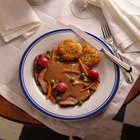
How to Prepare Chuck Tender Roast

How to Cook a Deer Neck Roast in a Slow ...
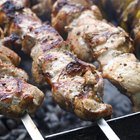
How to Cook a Tender Lamb Breast
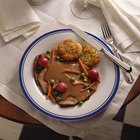
How to Use an Electric Roaster to Slow ...
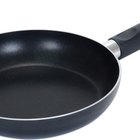
How to Cook Beef Top Round Pot Roast

How to Cook a Deer Brisket

How to Make a Blackbuck Antelope Roast
How to Slow Cook a Pot Roast With Beef ...

How to Cook Silverside on a Stove Top

Extracting Bone Marrow for Cooking

How to Cook Tender Roast Beef
How to Cook a Choice Chuck Roast
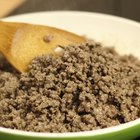
How to Cook Beef Mince

How to Cook Prime Rib Using an Oven ...

How to Cook a Beef Loin Tri Tip Steak ...
How to Cook a Standing Rib Roast on a ...
How to Cook Oven Spoon Roasts
References
Tips
- If the knuckle isn't peeled it has a thin layer of connective tissue, called silverskin, covering much of its top. Peel that away with a sharp knife, along with the partial fat cap at one end.
- The small cylindrical muscle in the middle of the knuckle, called the sirloin tip center, is very tender. It can be separated from the other two muscles and used as a small roast on its own, like a beef tenderloin, or cut into medallions for grilling.
Writer Bio
Fred Decker is a trained chef and prolific freelance writer. In previous careers, he sold insurance and mutual funds, and was a longtime retailer. He was educated at Memorial University of Newfoundland and the Northern Alberta Institute of Technology. His articles have appeared on numerous home and garden sites including GoneOutdoors, TheNest and eHow.